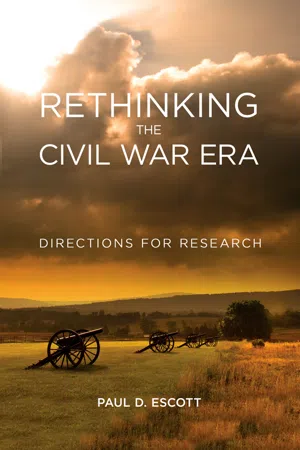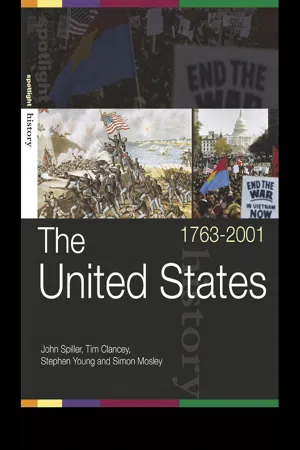History
Causes of the Civil War
The causes of the Civil War in the United States were rooted in long-standing tensions over issues such as slavery, states' rights, and economic differences between the North and South. The election of Abraham Lincoln in 1860, who opposed the expansion of slavery, further heightened these tensions, ultimately leading to the secession of Southern states and the outbreak of war in 1861.
Written by Perlego with AI-assistance
4 Key excerpts on "Causes of the Civil War"
Learn about this page
Index pages curate the most relevant extracts from our library of academic textbooks. They’ve been created using an in-house natural language model (NLM), each adding context and meaning to key research topics.
- eBook - ePub
Rethinking the Civil War Era
Directions for Research
- Paul D. Escott(Author)
- 2018(Publication Date)
- The University Press of Kentucky(Publisher)
1Understanding the Roots of WarA fundamental part of Civil War studies has always been analysis of the causes of the war. Except for books about Lincoln and military history, which have included the work of many nonacademic historians, probably no other topic has attracted as much attention. And perhaps in no other area have change and progress been so great. The overall way that we try to understand the roots of the war is very different now from the way it was understood in the 1960s or 1970s.When I began graduate school, many important studies focused their attention on the events of the sectional conflict, the friction points that eventually led to civil war. Through careful research, historians tried to understand the sequence of North–South conflicts, how each collision affected the Union, and how these successive clashes aggravated the tensions that brought about secession. Some interpretations had a pro-Southern slant, whereas others showed more appreciation for abolitionists or Northern antislavery sentiment. If many scholars were moving away from James G. Randall’s earlier argument that a “blundering generation” of politicians caused a needless war, the focus of their attention had not changed. Their priority remained to elucidate the debates and crises that produced growing tension.The efforts of this period produced some outstanding research and trenchant analysis. If Roy Nichols previously had identified the way battles over the right to petition broadened into fear of a Slave Power, others such as Joel Silbey and Michael Holt offered important new insights about party realignment. To understand the actions of political leaders, we continue today to turn to studies of the Compromise of 1850 as well as of Henry Clay or Stephen Douglas or John C. Calhoun or others, and valuable studies of such prominent leaders continue to appear. One of the most enduring of all the political histories is David M. Potter’s book The Impending Crisis, 1848–1861.1 - eBook - ePub
- Tim Clancey, Simon Mosley, John Spiller, Stephen Young(Authors)
- 2004(Publication Date)
- Routledge(Publisher)
Chapter 3 The Origins of the American Civil War, 1840–1861This chapter will examine the debates over slavery, states’ rights and federal rights, and the sectional differences which gave rise to the secession of the Confederate states and the subsequent outbreak of the American Civil War.Historical background Sources IntroductionThe problems of territorial expansion and attempts at compromiseEconomic differences and the moral implications of slaveryStates’ rights and nationalismSectional divisions and conspiracy theoriesLeadership: politicians and partiesConclusion 1 Understanding the Northern perspective2 Understanding the Southern perspective Historical skills1 Conspiracy everywhere2 Who was most to blame? EssaysExpansion and slaveryIrresponsible agitators and blundering politiciansMotives for secession and fighting Chronology
1820 Missouri Compromise 1831 First issue of The Liberator publishedNat Turner Revolt 1832-3 Nullification Crisis 1836 Texas won independence from Mexico 1840 Whig William Harrison elected President 1841 Harrison died and Tyler became President 1844 Democrat James Polk elected President - eBook - ePub
Interpreting Historical Sequences Using Economic Models
War, Secession and Tranquility
- Paul Hallwood(Author)
- 2020(Publication Date)
- Palgrave Macmillan(Publisher)
Union , or, was it both in some combination?Economic historians have established that the slave system in the USA was profitable but not hugely so with internal rates of return on plantation agriculture only a little greater than interest rates on railway bonds.1 Maintenance of a threatened profitable enterprise is of itself not a cause for war; there is also the matter of expected war costs: Would enjoyment of the economic benefits of slavery in the future be enough to outweigh these costs? And if it was thought that they did, how quickly might war costs be expected to be paid back? Waiting, say, 6 years is one thing, waiting 25 years is of a different order of magnitude because the payoffs would be near or beyond the life-expectancies of many slave owners. It is also natural to assess the likely probabilities of victory in a war of secession and to weight the expected benefits of the continuation of the slave system with those probabilities. Quantification of these issues as they relate to the American civil war is the intent of this chapter, but they also relate to the broader literature on the causes of civil as discussed in Chapters 1 –4 .An important question concerns what factors bind secessionist movements together? Several points stand out in the case of the American civil war : first, from the 1860 Census slavery was widespread in the Confederacy : in the lower south 36.7% of white families owned slaves; in the middle south 25.3% did.2 The combined proportion for the Confederacy was 30.8% but it was much lower in southern states not seceding, being only 15.9%. Secondly, Wooster (1962 ) found a strong positive correlation within southern states between slave ownership at the county level and delegates voting for secession. Specifically, where slaves made up more than 62.5% of a county’s population its delegates strongly favored voting for secession, while in counties with smaller slave populations this tendency was weaker. He concluded that delegates voting for secession did so because they saw it as the means of protecting the existing economic and social order based on slavery . Thirdly, as Abbott (1863 ) observed, there was a lot of intimidation in the south of slave owners who did not support secession by some of those that did. Fourthly, the US civil war bears out an observation of Collier and Hoeffler (2004 ) that ‘opportunity’ is an explanatory variable for civil war : the decentralized governance system of the USA - eBook - ePub
- Jack S. Levy, William R. Thompson(Authors)
- 2011(Publication Date)
- Wiley-Blackwell(Publisher)
The nature of the motive–opportunity debate will be elaborated below. Suffice it to say that most recent analyses have focused on opportunity factors–that is, what factors make it easier or more difficult to rebel for whatever reason. The lists of factors that are put forward tend to be multi -level, encompassing primarily systemic through group considerations. Motivation has been considered too difficult to capture in general terms. The onset–duration problem, most succinctly put, is that many of these opportunity factors (and motivation factors, for that matter) can be applied to explain why civil wars begin, why some become unusually protracted, or both. Although authors often specify that they are addressing either onset or duration, onset and duration still tend to become conflated. There is also a fair amount of disagreement. One person’s onset factor is another person’s duration factor and vice versa. We are no more likely to impose a tight order on these materials than the analysts already have, but we can try to communicate the nature of the disagreements. Thus, a different presentation strategy for civil war causes seems necessary. We will keep levels of analysis in mind but not insist that the arguments about the causes of civil war fit within them neatly.To set the stage for discussing different interpretations of civil war causes, we need to introduce briefly the “old war/new war” debate, which we mentioned in chapter 1. Emblematic of this debate is Kaldor’s (1999) perspective. Kaldor maintains that the type of warfare that became most prevalent in the past three to four centuries was closely tied to the relatively recent emergence of the nation-state organizational format. The primary goals of interstate warfare moved from a focus on territorial delineations and aristocratic inheritance squabbles to national and ideological disputes. In conjunction with these shifting goals, states became predominant and increasingly inclined to operate as blocs. Their armies transited through corresponding shifts of emphasis on mercenaries, professionals, conscripts, and back to professionals, this time with high technological proficiencies. Reliance on firearms gave way gradually to industrialized technology and successively greater lethality. All of these changes were supported by the expansion of the state’s bureaucracy, increasingly effective means of mobilizing resources from the population and economy, and tighter connections between state, military, and industry.8 Along the way and equally linked closely to the evolution of the modern state, a number of distinctions between what is public and private, internal and external, economic and political, civilian and military, and war and peace came into practice.Kaldor’s basic argument is that just as the wars with which we are most familiar were closely linked to the evolution of the modern state, the emergence of different types of political organization will lead to the supplanting of the old forms of warfare and associated conventions by new types of war and related norms. What is interesting is that the way these processes are currently working, at least in some parts of the world, is the exact opposite of the way they worked in early modern Europe. In earlier centuries, European rulers fought to establish control over specified territory and populations in order to create a fiscal foundation for state power. In doing so, they created a variety of distinctions, including one that differentiated domestic politics from the fluctuations of external politics. Maintaining this distinction meant suppressing domestic disorder, monopolizing armed forces, and staving off foreign attacks. Other things being equal, success in these endeavors led to political legitimacy within the territorial boundaries of the state, professionalized standing armies, and intermittent engagement in interstate wars.



